|
Aladdin Transition & Factory Hybrid Lamps
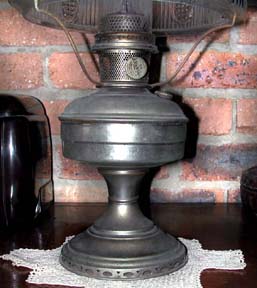
Model 11 - 12 transition lamp with model
11 top bowl joined to model 12 bottom bowl. As you can
see Aladdin seemed to have run out of model 11 burners before
they ran out of model 11 font parts. |
There are two keys to understanding the existence of transition lamps:
First, Aladdin was founded as a lamp marketing company that sold lamps manufactured by Plume And Atwood which had its own in house R&D group. Early on the Mantle Lamp Company (Aladdin) was just one of several companies purchasing mantle lamps or in some cases just lamp bases from Plume & Atwood (P&A). Aladdin purchased and marketed whatever P&A was manufacturing at the time. P&A was not building lamps specifically for Aladdin until the model 7. Aladdin had their own marketing schedule based upon the time of year people were most actively purchasing lamps while Plume & Atwood had their own schedule based upon getting their latest design improvements into production as rapidly as possible to stay ahead of the competition. Collectors often forget that the lamps were marketed by one company but made by a different company, each with their own business plans and schedules to maximize their own profit.
Second thing to keep in mind is manufacturing economics. P&A always tried to maximize its profits. This means every part of a previous lamp model that can be used as is or reworked to fit the next model was profit. Any scrapping of parts hurts the bottom line. Tooling that wears out with repeated use gets replaced as needed and sometimes tooling gets replaced to incorporate improvements to a lamp model. Until the introduction of the Aladdin model 7, tooling changes other than dies for the model number on the generator (flame spreader) and wick adjustment knob did not often get changed at the time Aladdin makes a model change. Minor changes to lamp height or chime locking are not a function of an Aladdin model change. It is a function of manufacturing tooling being replaced or manufacturing process improvements and not Aladdin model changes. Never ascribe a tiny dimensional change in a font to be Aladdin model specific.
Early on Plume & Atwood was making rapid improvements in both their centre draft and side draft burners as they gained experience with mantle lamp technology and where they identified construction weak points. They had their own schedule which did
not always coincide with the Aladdin model number changes. Prime examples were the change to the model 3 generator and Kone-Kap mantle gallery during model 2 production and the change over to the early Aladdin model 6 burner about 2/3rds of the way through the Aladdin model 5 sales year. Early
and late versions of an Aladdin model were created when the
P&A burner design improvements were implemented or
tooling wore out and was replaced during an Aladdin lamp model year.
During the model 11 and model 12 transition leftover model 11 font parts were used up by mixing with model 12 font parts creating obvious transition lamps. These American made transition fonts were shipped off to Aladdin Australia where they are sold. Also, during the model 11/12 transition, Aladdin UK assembled burners with both model 11 and model 12 parts to produce transition burners. Another good examples is good example of this is the very early model 12 burners. The first model 12 burner baskets were model 11 baskets with a hole cut in the bottom for the redesigned wick raiser.
Other than modifying model 1 inner wick tubes to hold the model 2 flame spreader Plume & Atwood just used up existing parts from previous model lamps on new models. Maximizing profits was everything and future collector sensibilities did not enter the picture. Any part not used was money wasted. It wasn't until Aladdin purchased the patent for model 6 from P&A that Aladdin got a say on model changes. And even then manufacturing profits was the primary objective. Transition lamps between adjacent models of Aladdin kerosene
lamps are the norm when already made parts existed and needed to be used up. I suggest that collectors
might wish to think twice about correcting what they
believe to be a hybrid between two adjacent models of Aladdin
lamps. That
might just be the way that particular lamp shipped from the
factory and you just might be destroying a piece of Aladdin
history.
To further complicate things, Aladdin also sold lamp parts
to dealers who might well have assembled lamps out
of their in stock parts in order to sell old model parts they had in stock
that might have otherwise sat on their shelves unsold.
Both Aladdin
and Plume & Atwood were in business to make money and not to have "correct
lamps" for
future collectors. |
Model 1-2 and Model 2-3
transitions:
The
Aladdin model 2 lamp was officially in production for just
4 months and underwent a large number of changes. For
practical purposes one could consider the model 2 to be a
morphing transition between the model 1 and model 3 lamps.
Early model 2 lamps used reworked model 1 galleries with
a brass ring inserted at the inside top of the gallery to
block off the top ring of holes (Change needed
for the #2 generator).
Part way through production the screw stop that limited
wick adjustment travel disappeared from the burner
adjustment shaft. Part
of production used a 2 part concave air distributor and
part used a one piece concave air distributor.
P&A changed the table font during the model run as well. Later
model 2 lamps have the threads hidden inside a raised collar
and had strengthening radial groves at the bottom of the
bowl. Except
for the thread pitch it looked like an early model 3 lamp
base (Chime shape was different in late model 3).
The last model 2 lamps used model 3 generators and the model
3 KoneKap gallery with the international patent markings. For
all practical purposes this lamp was a model 3 that used
the #2 burner, wick holder and a model 2 thread insert. A
late model 2 or an early model 3? I suspect these lamps
were sold into the model 3 production time frame until Aladdin
ran out of #2 burners. At this writing I own three
model 2 table lamps and each one is different.
Very early model 3 burners had the long slots in the base
cut the same as the model 1 & 2 slots. The common #3
burners have shorter slots the same as the model 4 and 5
burners. |
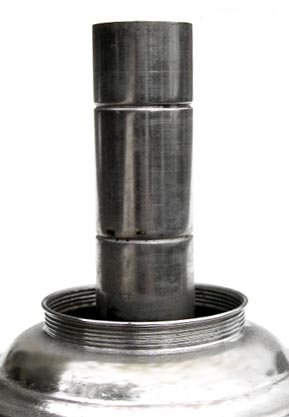
Model 1 Draft tube that was reworked
to fit a model 2 generator has rings for both #1 & #2 generators |
I should note that Plume and Atwood evidently
changed their chime assembling tooling sometime during model 3
production. This
means there is a noticeable chime shape difference between models
1, 2 and early #3 fonts vs the later model 3, 4 and 5 fonts that
were assembled with the newer chime tooling. There was another
chime tooling change during the model 5 production run as well.
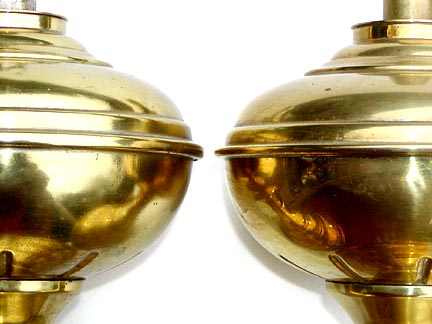
Chime on right made with the early chime
tooling (1, 2, early 3). Chime on the left made with next
generation of chime joining tooling (later model 3, 4 and slotted
burner model 5)
Model 3 - 4 transition:
Early model
4 lamps are found with model 3 galleries indicating that there
were still stocks of model 3 galleries on hand at the model
change. The primary difference between model 3 and 4 is the
generator and the labeling on the side of the
gallery and wick adjustment knob.
Also note that Plume and Atwood replaced the generator seat
forming tooling for the inner wick tube some time during model
4 production. The formed seats have a slightly different look
depending upon which tool was used. |
|
Model 5:
I have read that very early model 5 lamps were fitted with the
model 3-4 gallery that had either no markings or a patent Applied
for marking. Do date I have personally never seen one and
assume these are very rare on model 5 lamps. They are normally
fitted with the same gallery as the model 6.
Sometime near the end of the Aladdin 5 production plume and Atwood
replaced the tooling used to make the lamps. This resulted
in 2 very different lamps sharing the same Aladdin model number. Most
Aladdin model 5 lamps have the slotted burner and most of the
model 5 font lamps came with the classic model 5 1-1/2 quart
font.
Model 5 - 6 transition:
The last of the model 5 lamp production and the first year of
model 6 production shared the same tooling and were identical except
for the labeling. The tooling to join the chimes were changed
again. The new tooling produced a more rounded chime. A
new 1 quart font was introduced The
drip plate and mounting for the drip plate were changed for the
second year of model 6 production. The rod used to make the harp
for the hanging lamp was strengthened by going up one size in diameter.
This transition took somewhere between a year to a year and a half
to go between the standard classic slotted burner model 5 and the
common dated model 6 lamps.
A lot of interesting changes occurred during model 6 production
and I have identified at lest 5 versions of the model 6 burner.
I refer you to my web page on the Aladdin
model 6 for additional
details about changes within model 6 production.
Model 8 - 9 Transition:
One would normally think that except for the outer wick tube,
wick holder and wick riser nothing was carried over from the
model 8 to the model 9 and you would be right. Except
there was excess stock of model 8 galleries that were nickel
plated and
fitted to early model 9 lamps.
Second year model 9, model 10 and model 11 were all basically
the same lamp with real minor changes likely brought about
by replacement tooling. |
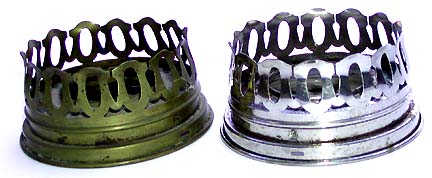
Model 7-9 gallery right & model 9-11
gallery on left. Nickel
plated model 7-8 galleries have been found on some early model
9 lamps. |
A few Aladdin London model 8 lamps have been found with London model 9 burners. Enough that this appears to be a factory transition lamp. The model 9 London burner says "Made in U.S.A." The model 8 London burner does not. My guess is that either Aladdin London had left over model 8 fonts at model 9 release and wanted to use them up as new model 9 lamps, or there may have been a legal issue with the model 8 not stating country of manufacture and the model 9 London burners were added early during the model 8 sales year. Either way, the model 8 font with London model 9 burner seems to be a legitimate transition version.
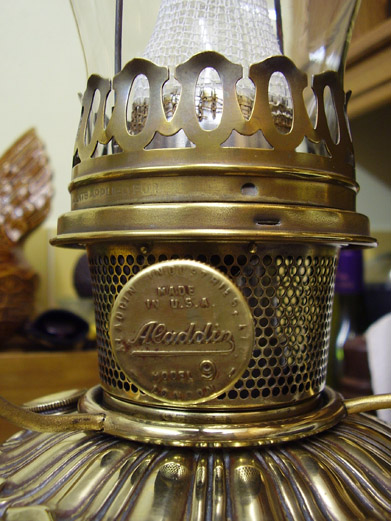
London model 8 - 9 transition lamp
Model 11 - 12 transition:
.
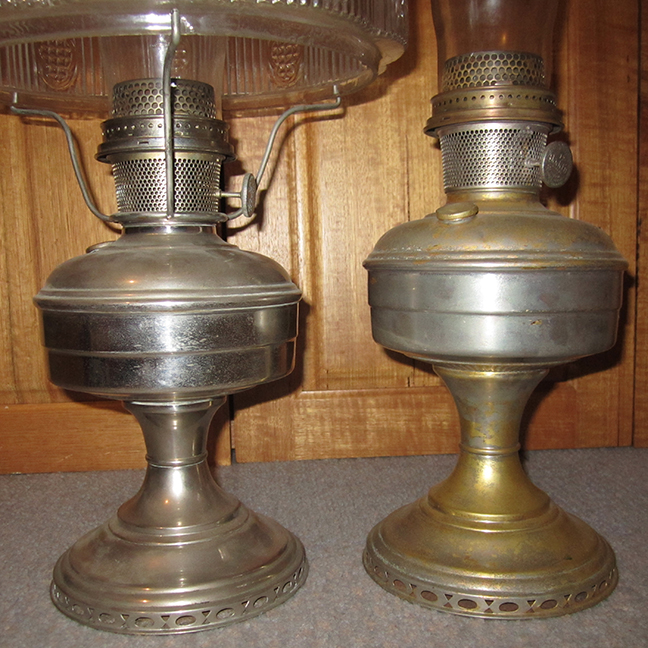
Two model 11 - 12 transition lamps which are proof positive that Aladdin used up existing parts from old models when switching over to new model lamps. Both lamps have the top of a model 11 bowl attached to the bottom of a model 12 bowl. One of the lamps has a model 12 upper stem piece while the other has a model 11 upper stem piece. What really confuses this the tooling used to make these lamps were in the Plume and Atwood factory in Connecticut but the burners on both lamps are Australian model 12 burners, likely manufactured at the P&A plant or in the UK. These lamps were evidently intended for sale in Australia.
Photo courtesy of A. Trueman
The big question is did the factory run out of model 11 burners
before they ran out of model 11 fonts and ship model 12 burners
on model 11 fonts. What confuses this answer is that Aladdin
ran a major burner upgrade promotion when the model 12 was
introduced. The
promotion was to get people to trade in their model 7 through
11 burners for model 12 burners. The likely reason
for the promotion was to quickly build sales numbers on the
new Lox-on mantles and chimneys. This in turn provided the
retailers with more incentive to make space on their shelves
for these new parts and made production lines profitable faster.
I personally am in the side that advocates that the factory
ran out of #11 burners before they ran out of the fonts. There
seems to be a much higher percentage of model late 9, 10 and
11 fonts found with #12 burners than of model 7, 8 and
early 9 fonts found with #12 burners. I can not justify
this by saying that people who recently purchased a lamp were
more apt to trade in perfectly functional almost new burners
than were people who had purchased their lamps a few years
earlier. It
seems to me that people with old burners would be most likely
to want to upgrade and that there would be a higher
proportion of model 7, 8 and early 9 fonts with model 12 burners
than later fonts if Aladdin did not sell a transition
lamp that had model 11 fonts and #12 burners.
The first model 12 burner baskets were model 11 baskets with a hole cut in the bottom for the redesigned wick raiser. This allowed the factory to use upon hand model 11 burner baskets. |
|
Model 12 to Model A:
I personally know of no transitions to these lamps. Except
for the flame spreader and gallery, the burners were completely
different as were the fonts. The air distributors on the first model A burners were pressed from blanks stamped for the model 12 air distributor. The ring of holes nearest the centre extends into the upward curve around the outer wick tube. The curve starts further from the centre because the wick tube is bigger. Later model A air distributer production moved the holes away from the centre slightly so the holes don't extend onto the curve (per Andy Grahm-Cumming ).
UK model 12 to model 14:
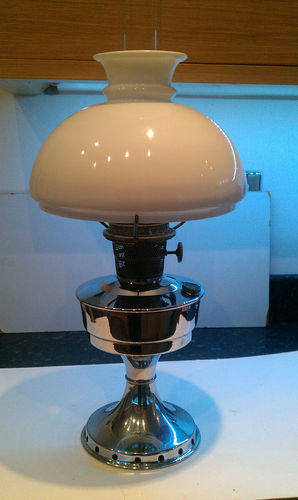
|
In the grand tradition of using up parts on hand instead of throwing them away and taking a financial loss here are two Aladdin UK table lamps that have a UK model 12 foot attached to a model 14 bowl and burner. |
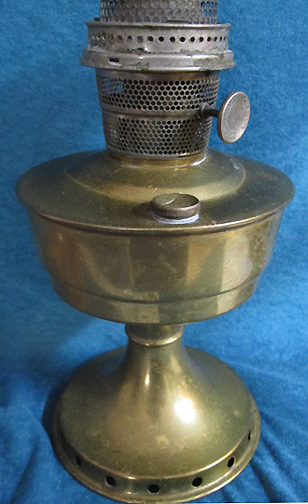
|
Model 12 and Model B: hybrid burners:
Models 12 and B burners were both in production from the
time that the model B was introduced until a flood destroyed
the tooling for both burners in 1955. During
that time if production of one burner ran out of stock, the
corresponding part from the other model burner was used until
additional parts arrived. |
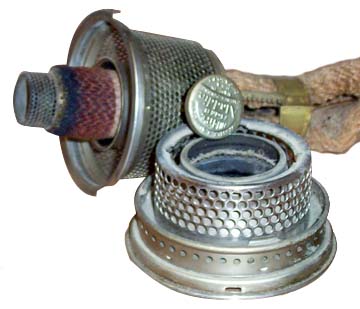
Hybrid burner with model 12 burner base and model B wick adjustment
knob. |
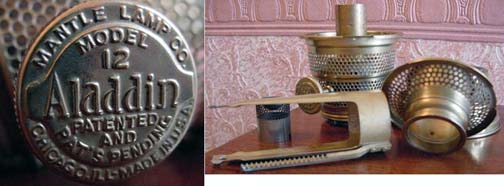 Model B burner base with Model 12 wick adjuster knob
Model B burner base with Model 12 wick adjuster knob
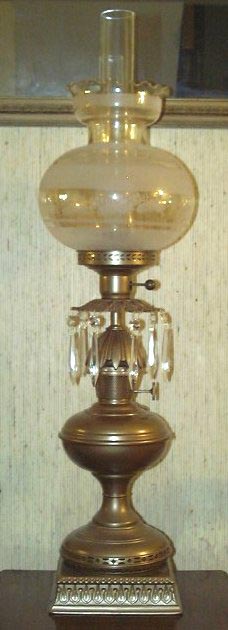 |
And of course there are the hybrids made from Aladdin lamps by owners
People often get inspired to make their own creations out of Aladdin lamps or Aladdin lamp parts. Most of these can be easily recognized as not a factory Aladdin. But sometimes people just assemble parts that fit together to make a complete lamp to sell and offer it is an "Original antique Aladdin lamp". One of my primary reasons for creating and building this web site is to help people identify what parts make up a proper Aladdin lamp. It is easy to get misled and spend a lot of money on an after production Hybrid.
Unfortunately there are a few people out there who are well versed in Aladdin lamps that create replicas of rare expensive lamps out of common lamp parts. There is not a whole lot I can do to help people who get taken in by these knowledgeable and skilled lamp crooks.
There are quite a few Niche Aladdin lamps that are now poorly documented or largely undocumented. Many of the pedestal lamps came in several variations. Mostly the ones with wood bases. They can be hard to tell from hybrids I am trying to document as many of these as possible in the hopes of helping others figure out what they have.
Lamps that have a part or two from the next earlier or later model could easily be a factory hybrid. Or it could just be that someone needed a part to get a lamp working and that was what was available. Unless the part in question was finished differently or modified by the factory to fit there is no way to know for sure if a lamp with an adjacent model part is actually a hybrid. or not. You just take your best guess and either leave it as found or possibly destroy a factory hybrid. by making it "Original".
When Aladdin introduced the model 12 they had a big ad campaign to convince people to "upgrade" their existing lamp with a Model 12 burner. The more #12 burners out there the quicker dealers will start stocking Lox-On Chimneys and mantles. Model 12 burners on model 7 through 11 lamps were mostly added by customers during Aladdin's Upgrade to model 12 burner campaign. However, it appears that Aladdin ran out of #11 burners before they ran out of #11 table lamp bases so a number of model 12 burners on #11 table fonts are likely to be factory hybrid lamps, or just as easily a lamp that was "upgraded" during Aladdin's big push to get people to change over to the new chimney and mantle.
Aladdin sold 5 inch diameter, industry standard oil pot lamps to be upgrades to other brands of lamps that used a round wick oil pot, such as the Gone With the Wind style table lamps and many hanging lamps. Aladdin used their oil pots in a model 6 floor lamp, a couple model 12 floor lamps and in their various model 12 vase lamps. A nickel plated model 12 oil pot with 3 feet was sold by Aladdin France as shelf lamps. If you see an Aladdin oil pot used in other lamps it will almost always be an after market oil pot replacement in a different brand lamp and not an original Aladdin lamp.
And of course there are a lot of reproductions and look alike lamp bases that fit Aladdin burners out there. These are generally glass lamps. I suggest that before you spend more money than you might for a reproduction or look alike that you research the lamp model first. The Aladdin Collectors Manual and Price guide put out periodically by J.W. Courter caries the best information about identifying Aladdin reproductions and I highly recommend having one with you when looking for glass lamps and shades. There is also a lot of information in Courter's book "Aladdin the Magic Name in Lamps". If you are going to spend serious money on glass lamps or shades you need to get both and study them. They contain the results of a lot of research. Since I have little interest in Aladdin glass table lamps or old shades this site will likely never have the kind of information on replicas that Courter's books have. |
|
| If you would like to discuss any of the contents
please feel free to
.
© 2002, 2015 by TeriAnn
Wakeman. All rights reserved.
This web site is not affiliated with Aladdin Mantle Lamp Company.
Aladdin, and Lox-on are registered trademarks of Aladdin Industries
LLC
|
![]()
![]() Contents > Aladdin
Transition lamps
Contents > Aladdin
Transition lamps 





